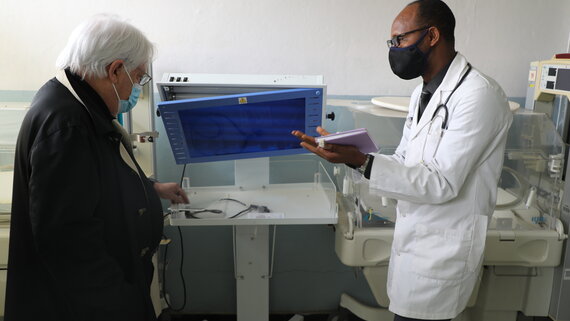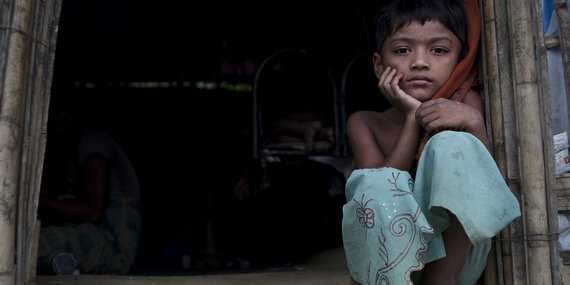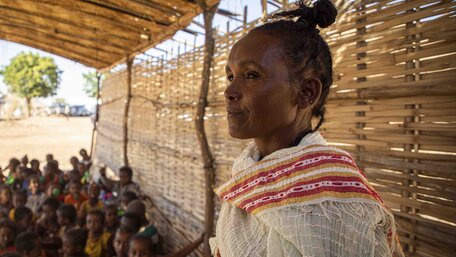Chakmakul, Bangladesh
A young girl sits by the entrance of her home in Chakmakul, a refugee camp sheltering Rohingya refugees in Cox's Bazar, Bangladesh. The world’s biggest refugee camp battles regularly with the onset of monsoon rains. The Bangladeshi Government and humanitarian organizations on the ground work hard to minimize the risks from landslides, flash floods, waterborne diseases and, ultimately, loss of life. Thousands of people face dire circumstances, as conditions in the camps are expected to dramatically worsen with the onset of heavy rains. UNICEF/Siegfried Modola
2021 was a year of challenge and achievement. At the start of the year, the pandemic was hitting hard. Combined with ongoing conflicts and the climate crisis, it has driven up humanitarian needs. Children, especially girls, are missing out on their education. Women’s rights are threatened. Multiple famines loom. Individual lives and livelihoods, regional and national stability, and decades of development are at risk. The cost of inaction in the face of these challenges is high.
But this has also been the year that the humanitarian system rose to the challenge, overcoming seemingly insurmountable obstacles and showing what can be done when the international community comes together. Thanks to generous donors, the humanitarian system delivered food, medicines, health care and other essential assistance to 107 million people this year.
In South Sudan, over half a million people have been brought back from the brink of famine. In Yemen, more than 10 million outpatient medical consultations were carried out, and 344,000 safe births assisted. The humanitarian system got hundreds of millions of dollars in cash assistance into the hands of people struggling to survive.
The results achieved by national and international humanitarian workers are a credit to the determination and capability of the humanitarian system and to the donors who support it. They deserve our gratitude. What they really need is our support.
The humanitarian system is strong, but the challenges are increasing. New battlefields have emerged, including in northern Ethiopia, where millions now need aid to survive. Across Ethiopia, humanitarian needs are growing at an alarming rate. As the conflict spreads from Tigray into Amhara and Afar regions, thousands of people are being displaced. Elsewhere in the country, conflict, drought and locusts are pushing more people to the brink. In the Tigray region, I met survivors of horrific sexual abuse whose horizons were limited to survival.
In Afghanistan, needs are skyrocketing. There I saw systems on the brink of complete collapse and the rights of women and girls under threat. In Myanmar, the humanitarian situation is fast deteriorating because of growing conflict and insecurity. Conflict remains in parts of the Democratic Republic of the Congo, the Central African Republic, Syria and Yemen.

Hawzen, Ethiopia
The Director of Hawzen Referral Hospital explains to ERC Martin Griffiths how, after being used for eight months as a military base, the facility was left inoperative. Around 160,000 people who live in the area were left without proper medical attention. Equipment including the neonatal ICU (pictured here) was vandalized and destroyed. To restore services, all equipment and medicines will have to be replaced.
OCHA/Saviano AbreuMeanwhile, the climate crisis presents an immediate existential threat to the lives and livelihoods of many. In 2020, extreme climatic and weather events drove almost 16 million people into food crises in 15 countries. And food crises in turn fuel further violence and exploitation of women and children. Among the top 15 countries classified as most vulnerable and least ready to adapt to climate change, 12 had a Humanitarian Response Plan in 2020. In 2021, climate change joined conflict as a root cause of famine, as evidenced in drought-affected Madagascar, where climate is driving famine-like conditions.
Humanitarian action must adapt to the climate crisis. We cannot risk overlooking other threats while we fight the climate crisis. We all must continue advocating for the full and equal participation of women and girls at all levels of education, the economy and public life. Decision-making must involve them.
This Global Humanitarian Overview 2022 projects humanitarian needs for the coming year. In many respects, the outlook it presents is bleak. But I am encouraged. Not only by the results the humanitarian system can achieve but by its innovation.
Anticipatory action can help mitigate the consequences of climate change. Governments and humanitarian agencies saved millions of lives by taking early action in 2017 to prevent famine in north-east Nigeria, Somalia, South Sudan and Yemen. The humanitarian system is also taking determined action to prioritize equity, inclusion and access to information for affected communities. It must work ever harder to protect the most vulnerable from sexual exploitation and abuse.
The challenges are immense, and funding remains well below what is needed.
This is the moment to double down. To protect hard-won gains, to stand by those who need our support, and to take the kind of decisive action that is in everyone’s interests.
We need your support.
Martin Griffiths
References
- According to the Notre-Dame Global Adaptation Initiative (ND-GAIN). ND-GAIN measures a country’s vulnerability to climate change in combination with its readiness to improve resilience.






